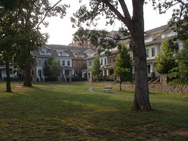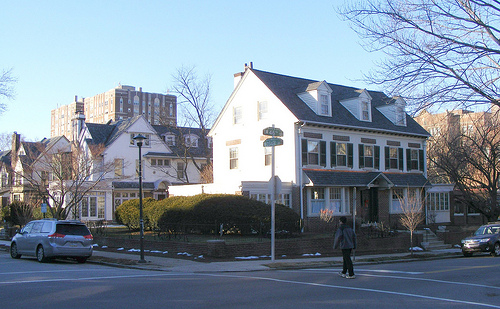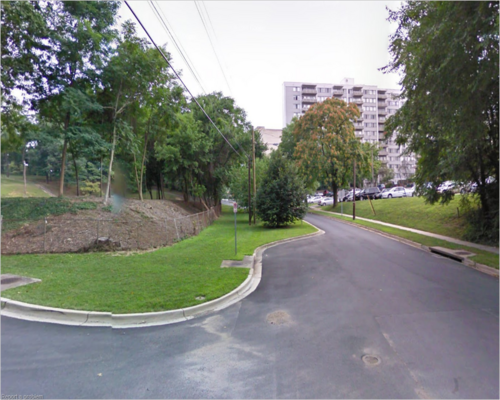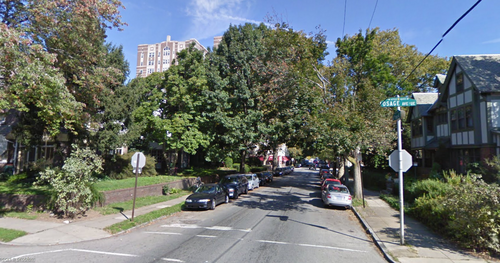Different housing types can mix if designed propertly

Photo by thecourtyard on Flickr.
Neighbors of Chelsea Court, a proposed townhouse development at the site of the former Chelsea School outside downtown Silver Spring complain it’s too dense for a neighborhood of single-family homes, and last month, the County Council agreed. But why can’t different housing types coexist?
Local developer EYA bought the Chelsea School’s campus in May 2010 after the private academy announced they were closing. EYA, which has built dozens of townhome and condominium projects around Greater Washington over the past twenty years, wants to build 76 townhomes on the site, located in the Seven Oaks neighborhood less than a block from downtown Silver Spring.
To do so, they need the County Council to change the property’s zoning, which right now only allows single-family homes.
There’s a group of neighbors who say they’d prefer detached houses, while county planners and blogger Silver Spring, Singular, who also lives in the neighborhood, point out that there’s already high-rise buildings in the area.
Neighbors will always complain that a development is “too dense” on the basis of overcrowded schools or congested roads, though that isn’t really an issue with two-bedroom townhouses within walking distance of a large urban center. So let’s talk about the other issue: is it a foregone conclusion that you can’t have single-family homes, townhomes and apartments in the same neighborhood? Not at all, especially if they’re designed to get along with each other.
This is the corner of 47th Street and Osage Avenue in West Philadelphia, about three blocks from my house here. The specific neighborhood is called Garden Court, and it was built in the 1920’s as a “streetcar suburb” for middle- and upper-middle-class families. Even as much of West Philadelphia fell into disinvestment and poverty, this neighborhood has been relatively stable. Today, it’s home to many students and faculty at Penn, Drexel and other universities in the area. Even a rowhouse here will easily run above $500,000, a bargain by D.C.-area standards but expensive for here.
Take a look at this intersection. On three corners are large, single-family homes. Next to them are duplexes, maybe a little smaller but still more than enough room for a family. Go west on Osage about a hundred feet, or east one block, and you’ll find rowhouses. See that big building poking through the trees? That’s a high-rise condominium, just a block north.

Different types of houses mix well in my West Philadelphia
neighborhood, so why can’t they in Silver Spring?
This neighborhood’s not a bad comparison to, say, Woodside Park or Seven Oaks, neighborhoods adjacent to downtown Silver Spring. Woodside Park and Seven Oaks were built around the same time. Though those neighborhoods have bigger lots and lack sidewalks, they were intended for the same, well-heeled clientele. And both have a mix of different house types, sizes and heights.
Nonetheless, Garden Court has the benefit of being built all at once, so the high-rise building has similar details and materials as the single-family houses. In the neighborhoods around downtown Silver Spring, you might have single-family homes built before World War II, apartment buildings built in the 1960’s, and townhouses built more recently.
Certainly, living next to a genteel 1920’s apartment house might be nicer than living next to a 1960’s Modernist apartment tower. It’s not surprising that some people living in neighborhoods like Seven Oaks are uncomfortable with new development when they have to contend with buildings that aren’t so sensitive to their context.

Townhomes in Chelsea Court will look at Colesville Towers,
a 1960’s-era apartment tower. Image from Google Street View.
Yet my example shows that single-family houses and townhouses and apartments can play together if done right. Like the different housing types in my West Philadelphia neighborhood, the proposed Chelsea Court houses use similar materials and detailing as existing homes nearby, while providing a opportunity for families who can’t afford or don’t want a detached house to live there. What makes Silver Spring a great place to live is that it attracts a mix of people, and that comes from having a mix of housing styles, types and prices. And like I wrote last week, those qualities are threatened when we try to push out anyone or anything that seems “different” than what’s already there.
Like any development in an existing neighborhood, Chelsea Court needs to fit in with its context. But that doesn’t have anything to do with how dense it is. In fact, an urban center like Silver Spring needs new residents within walking distance of its shops, restaurants, and extensive public transit. What we can do is ensure that these new townhouses are designed to complement their single-family neighbors. It’s been done before, and we can do it again.

